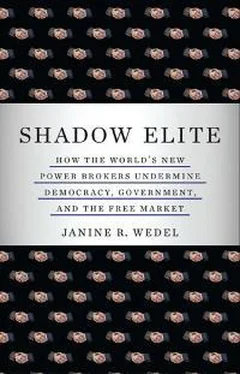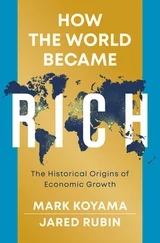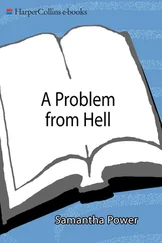These changes help a variety of actors, including our new agents, to wend their way through state and private domains. These operators help organize the interrelations between state and private (as did their counterparts in 1990s transitional central and eastern Europe), and thereby bring about new institutional forms of governing and of power and influence. Adept at performing, and with ambiguity often surrounding their roles, they slip through the accountability cracks. Observers become more reliant on what the players themselves say they are doing, further removing public decision making from the citizens’ purview.
Who Is the Government?
Defining just who the government “is” is more difficult in the United States than perhaps in any other developed country. This isn’t a question of Republican versus Democrat or independent, or federal versus state or local administration. Instead, the question gets at the array of actors who do much of the actual work of government. 7
The American model of governing builds on the nation’s rich tradition of voluntary associations playing a role in public and civic life; the participation of a plethora of entities in governing can be considered not only as a natural outgrowth but also as a strength of the American system. In 1969, in The End of Liberalism , political scientist Theodore J. Lowi foresaw government being administered more and more by the private sector and its lobbyists—and he was prescient in understanding the implications. Not only are policymaking and implementation today scattered among many actors—official, shadow, and quasi-governmental—but the burgeoning quantity and roles of private sector entities vis-à-vis government are fraying the whole system of accountability. 8
Over roughly the past six decades, but especially since the end of the Cold War, the architecture of much of federal governing has transformed. A major pillar of this structure is the shadow government (briefly described in Chapter 2) that today comprises the companies, consulting firms, nonprofits, think tanks, and other nongovernmental entities that swell the ranks of contractors. These private actors are interdependent with government, involved in all aspects of governing and negotiating “over policy making, implementation, and enforcement,” as one legal scholar has noted. Where once federal employees executed most government work, today upwards of three-quarters of the work of federal government, measured in terms of jobs, is contracted out. Although this practice is not new, it has accelerated and assumed new incarnations, most notably since the early days of the Clinton administration. 9
According to the U.S. Congressional Research Service (CRS), “government” today encompasses mixed state-private entities, which have proliferated and play a greater role than ever. They take several forms. One is the hybrid, or “quasi-government” organization, defined by the CRS as “federally related entities that possess legal characteristics of both the governmental and private sectors.” In recent decades these organizations have boomed not only in numbers but also in import. They run the gamut from the National Science Foundation to RAND to certain venture capital funds designed and managed almost as if they were in the private sector. Another form comprises federal advisory committees that provide guidance to more than fifty government agencies, whose members have grown in numbers from some 52,000 in 2000 to 65,000 in 2008. The GAO has called the committees the “fifth arm of government” for their “important role in the development of public policy and government regulations” in arenas ranging from defense, homeland security, and space exploration to food safety and stem cell research. 10
These mixed state-private entities, along with a host of other actors on the governmental stage, have revamped governing. So altered is the landscape that the term “governance,” a relative newcomer to the vocabulary that refers to rule by a combination of bureaucratic and market entities, now often substitutes for “government.” The shadow government, which devises and implements so much policy and forms the core of governance, warrants close examination. It is the elephant in the room.
The Overshadowed Government
I asked the well-known conservative thinker and publisher Alfred S. Regnery, who had just given a book talk on the importance of limiting the size of government, what he made of the fact that three-quarters of employees doing the work of the federal government are now contractors and that the federal budget for services increases by the day. He was taken aback. It was immediately apparent that the subject was not on his radar. The façade of small government—so effective as political rhetoric espoused by Republicans and Democrats alike—appears as a perennial ruse in American public discourse despite the enduring reality that de facto federal government has long been growing. 11
The story is best understood in the larger historical context stretching back to the end of World War II. According to Dan Guttman, coauthor of the 1976 book Shadow Government , U.S. reformers decided to use contractors to “grow” government after the war. While politicians and pundits of nearly all stripes were decrying “big government” and endorsing its containment, shadow government was becoming evermore firmly entrenched. 12The redesign of governing that championed the privatization and deregulation of government (the first transformational development) gave shadow government a huge push. But many of the most dramatic alterations have occurred since the end of the Cold War (the second transformational development), particularly during and since the Clinton administration. The advent of evermore complex technologies (the third transformational development), which gave birth to information technologies upon which society now relies and which the U.S. government largely outsources, tipped the balance even further. The result is that many inherently government functions now find a comfortable home outside government.
Underlying the growth of shadow government is the effort to cap or even reduce the number of civil servants, which has been making headway for some sixty years. The shadow government is the creature of these attempts to curb official government. While it may be the elephant in the room, we know little about the nature of the beast. Government scholar Paul C. Light compiles the most reliable available figures on contractors, but these are inexact. The number of contract workers as compared with civil servants, uniformed military personnel, and postal service employees increased steadily over the last two decades. In 1990 roughly three of every five employees in the total federal labor force (including contractors) worked indirectly for government—in jobs created by contracts and grants, as opposed to jobs performed by civil servants, uniformed military personnel, and postal service workers. By 2002, two of every three employees in the federal labor force worked indirectly for government and, by 2008, the number was three out of four. Phasing out official government grows the shadow government: The very necessity of upholding the façade of contained government in fact begets the opposite. 13
An even more reliable barometer of the growth of shadow government is the U.S. federal budget. Under Bush II, shadow government, driven in part by the increase in demand for military, nation-building, and homeland security services after 9/11, captured record levels of procurement (or contract) spending. The cost of services alone (not counting goods) provided by contractors soared from some $125 billion in 2001 to an estimated $320 billion plus in 2008. Nearly 90 percent of NASA’s and the Department of Energy’s budgets go to contracts. The American federal government today is the world’s largest customer for goods and services. Where once the government procured mainly manufactured goods from the private sector, a huge and rising portion of government purchases is now for work that would once have been performed by the civil service. 14
Читать дальше












